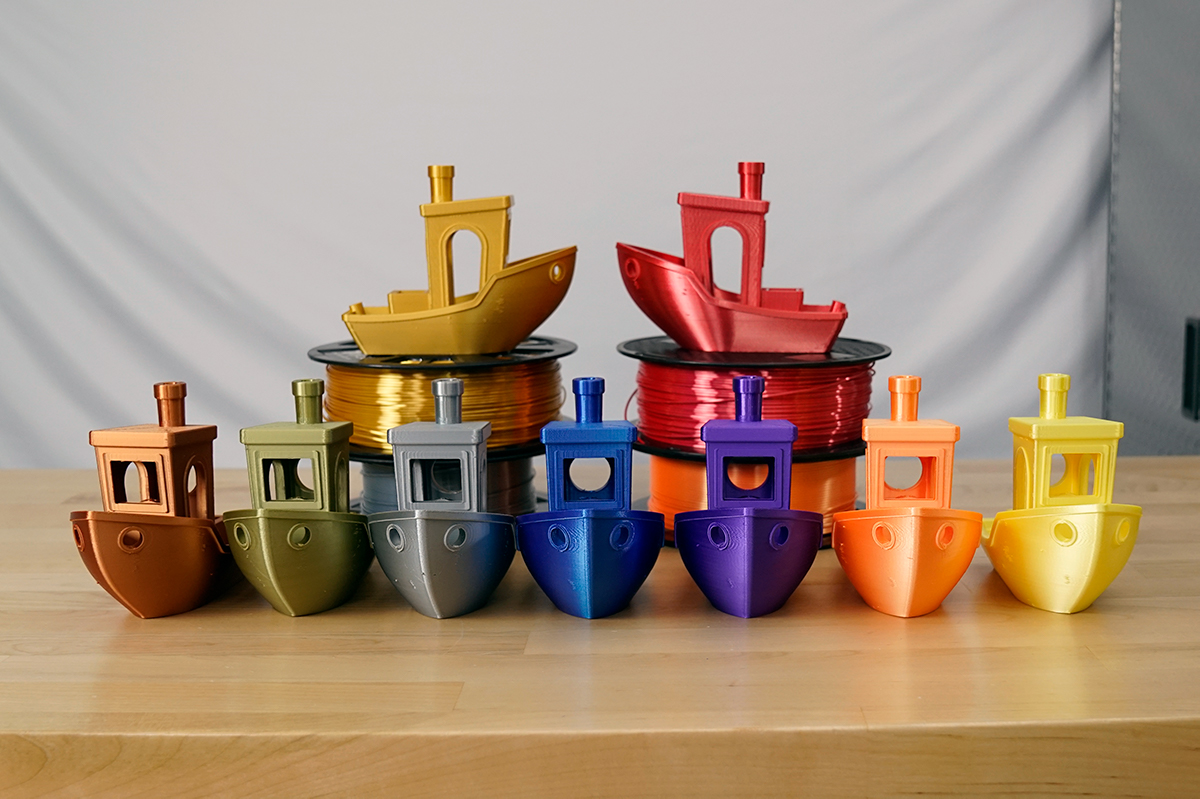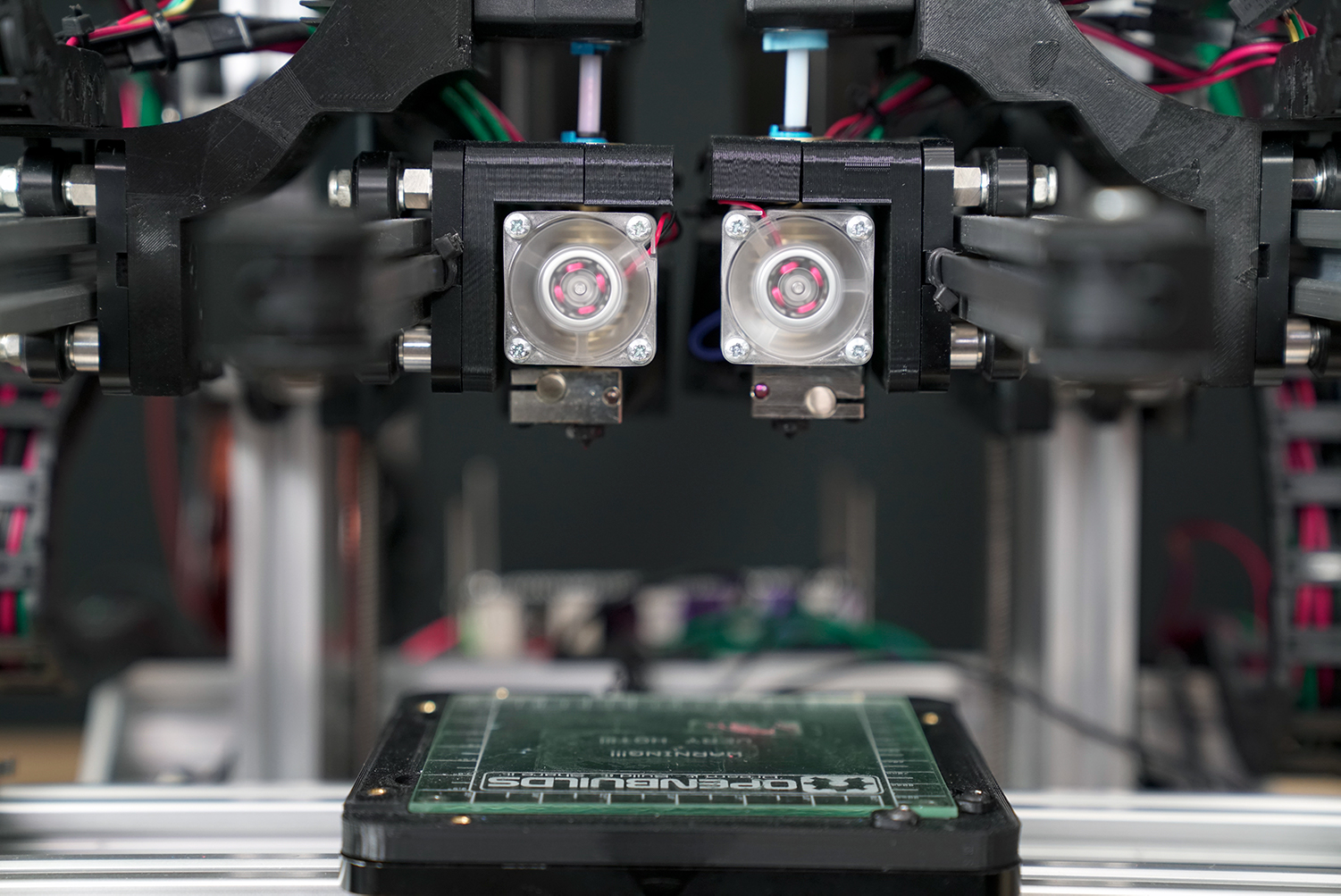Overview
A 3D printer should be calibrated prior to its first print or when it is functioning unexpectedly. Follow the steps below to have your 3D printer operating at its peak performance.
1. Check the printer’s dimensional accuracy
The utility of a 3D printer comes from its ability to accurately reproduce digital 3D models in real life. 3D printers would not be as useful as they are if the printed parts were off in dimension by 10%. Fortunately, this is not the case. FFF 3D printers are capable of dimensional tolerances as low as 0.15%. In other words, the dimensions of a 100 x 100 x 100mm cube printed over and over again would only vary by 0.15mm.
The best way to check the dimensional accuracy of a printer is to move each carriage separately (if possible) with a slicer or g-code sender, and then measure the resulting movement with a dial indicator. If your software of choice instructs the printer to move 1mm in the X-axis then your dial indicator should measure 1mm ± 0.05mm. I also recommend measuring the repeatability of each carriage’s movement by moving the carriage back and forth the same distance. If the readings on the dial indicator change with time, then most likely there is an issue with backlash in the transmission setup of your printer. It is possible to use a ruler or calipers to make these measurements but dial indicators are relatively inexpensive and ideal for this type of calibration.
Troubleshooting
If you find that your printer fails to accurately reproduce movements, then I have a couple troubleshooting items that you can perform. 9 out of 10 times the failure of a printer to move the proper distances is a result of an incorrect steps/mm value in the configuration file. It is easy to mix up a 16T pulley with a 20T pulley or have the wrong lead value for your lead screw. Double and triple check your calculations for the steps per mm for each axis before taking any drastic measures. Use an online calculator like this one to remove the possibility of making an algebraic error.
If you still find that your printer fails to move accurately then check the tension of your belts (if used). Timing belt should be tight. When in doubt its best to include a belt tensioner like this one
2. Check the printer’s squareness
A printer that has passed step 1 of this calibration guide (i.e. it moves accurately) may still produce parts that are dimensionally inaccurate. How can that be? Well, most likely the printer is not “square”. Each axis of a “square” printer will be at 90 degrees with respect to the other axes. For example purposes let’s say a printer has an X-axis that is ever so slightly angled upwards. As the carriage moves along this angled axis some of movement in the X-direction will be lost to the Z-direction. If the axes are very misaligned, then it will be impossible to have successful prints because the filament will not properly adhere to the build platform. Axes that are ever so slightly angled towards each other may still be capable of printing parts, but these angles will be translated to the part.
The easiest way to make sure that you have a square printer is to compare the angle of each axis to the other two axes with an appropriately named engineer’s square. If an axis fails to match the angle of the engineer’s square then you can untighten the bolts securing the rail/frame and then tap the rail/frame with your finger until the angle is corrected. However, my preferred method to measuring the squareness of my printer is to attach a dial indicator to the extruder, and zero the indicator on the print bed. If the value of the indicator remains unchanged as the extruder is moved around then all is good. The dial indicator method is more quantitative than engineer’s square approach, which is why I prefer it.
3. Measure the extrusion of filament
The accurate movement of filament through the extruder is equally as important as the accurate movement of the carriages. The amount of filament that should be extruded at any point during a print depends on a variety of factors, including the print speed and layer height. But don’t worry you don’t need to perform any complex calculations. The only measurement that you need to check is the steps per millimeter for the extrusion drive. To elaborate further, the steps per millimeter refers to how many steps of the extrusion motor does it take to push 1mm of filament into the extruder. If you purchased an assembled extrusion drive, then this conversion value can be found in the technical specifications on the manufacturer’s website.
Even if you were able to locate the steps per millimeter value of your extrusion drive off the manufacturer’s website it is still a good idea to check this value by performing the following test. Use calipers or a ruler to draw a line on the filament 10mm from the top of the extrusion drive (or bottom if using a Bowden extrusion drive). It will be hard to get a super accurate measurement because the filament will have some curvature to it, but right now we just want to be in the ballpark. Then instruct the printer to extrude 9mm of filament. Remeasure the black mark which should be 1mm above the extrusion drive now. We will fine tune the extrusion of filament when discuss the extrusion multiplier (step 5).
Troubleshooting
If you find that your extrusion drive is inaccurately extruding filament then first double check the steps per mm. The next step is to play with the extrusion drive tension. In a properly functioning extrusion drive the filament is pinched and forced down into the barrel of the extruder. Most if not all extruders will have a way to control how much force the filament is pinched with. Typically, a thumb screw on the side of the extruder can increase or decrease the pinching force. Too little pinching force and the extrusion drive will not be able to grip the filament and too much pinching force and the extrusion drive will bite into and grind up the filament.
To find the happy medium between too much and too little force I recommend extruding some filament and then retracting the filament completing out of the extrusion drive. I then inspect the filament for bite marks. Bite marks from the hobbed or drive gear should be present, but the filament should be intact and there shouldn’t be any powder on the filament, which would be caused by the pinching force being too high and the filament being ground up.
4. Print a cube
At this point you are probably eager to start printing, and if you followed all the previous steps your printer should be close to being ready. There are a couple more settings that need to be dialed in before you are off to the races. These settings include the print speeds and accelerations as well as Z-axis offsets. Print speeds and accelerations includes not only the velocity and acceleration at which the X, Y, and Z axes move but also encompass a concept known as jerk speed. If you are not familiar, jerk speed is the maximum instantaneous speed change a carriage will make without acceleration. (This definition of jerk differs slightly from the mathematical definition, see here.) For example, if the extruder is stationary and needs to extrude filament from its current location until point A, then it will go from stationary to the jerk speed instantaneously and then accelerate to the print speed. Low jerk speeds are incompatible with fast 3D printing, and generally, higher jerk speeds allow for sharper corners and smoother circles. Here is an informative Reddit post talking about jerk speed.
The best way to calibrate these settings is to print a simple cube. You can download my STL file of a 30 x 30 x 30 mm cube here, design your own, or find one on Thingiverse. After importing the cube into your slicer of choice I recommend setting a conservative extruder print speed, acceleration, and jerk speed of 50 mm/s, 3000mm/s2, and 10 mm/s, respectively. The jerk speed and acceleration are not accessible in the slicer and have to be changed in the firmware configuration file.
While the cube is printing listen to the sounds of the stepper motors, especially when they are accelerating and deaccelerating around the corners. The frequency of the stepper motors should ramp up or down when changing speeds. If there are sharp changes in the sounds of the steppers then the motors could be stalling. Typically, decreasing the speeds and acceleration of the printer should remedy this problem. It’s also recommended to keep a close eye on how much the printer vibrates when the print head switches directions. Vibrations will influence the quality of your printed part. Vibrations can be decreased by reinforcing the printer’s frame or decreasing the jerk speed.
"Help the cube fails to adhere to the print bed"
Maybe you were unable to calibrate the print speeds because the first layer of the cube would not stick to the print bed. If this is the case, then I first recommend that you read the print bed section, and learn about part adhesion and bed leveling. If you have properly prepared the print surface and the cube is still failing to adhere then most likely your printer’s extruder is too far or too close to the print bed. This distance can be fixed by applying a Z-offset in the slicer. This parameter is typically found in the G-code settings tab, but this will depend on your slicer of choice. Applying a negative Z-offset will bring the extruder closer to the print bed, which should help with first layer adhesion.
5. Calibrate the extrusion multiplier
At this point your printer should work.
6. Exotic calibration prints
Overview
...
PLA

ABS

Placeholder
External Resources
There are a lot of different ways to successfully build a 3D printer, many of which are not covered on this website. If you want to learn more about firmwares, then click through some of the links below to external websites and forums.
Recommended Products
The table below contains parts specific to this section that Dr. D-Flo uses and recommends. Depending on your printer build these parts may or may not be compatible. It is best to use the products below as a launching point to explore similar products on the linked websites. Affiliate links may be present below (depending on the vendor).
